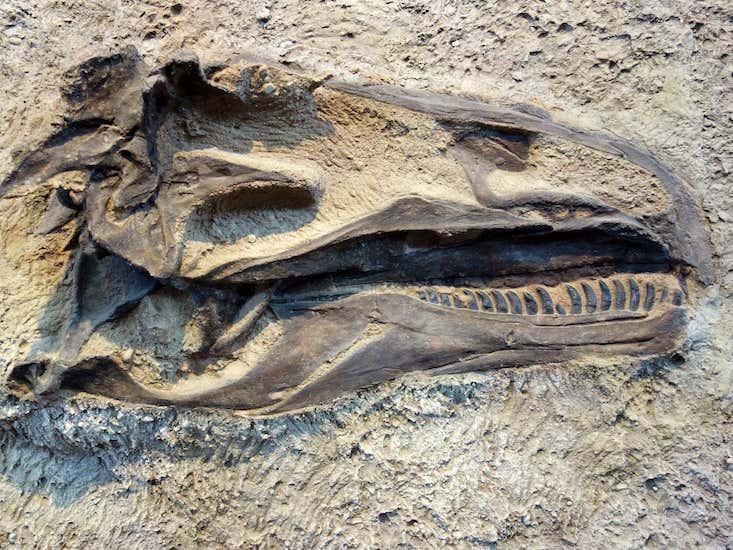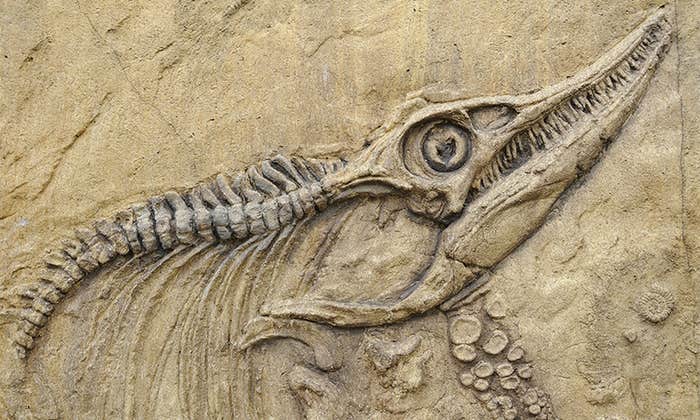
What color were the dinosaurs? If you have a picture in your head, fresh studies suggest you may need to revise it. New fossil research also suggests that pigment-producing structures go beyond how the dinosaurs looked and may have played a fundamental role inside their bodies too. The latest findings have also paved the way for a more accurate reconstruction of the internal anatomy of extinct animals, and insight into the origins of features such as feathers and flight.
Much of this stems from investigations into melanin, a pigment found in structures called melanosomes inside cells that gives external features including hair, feather, skin and eyes their color—and which, it now turns out, is abundant inside animals’ bodies too. “We’ve found it in places where we didn’t think it existed,” said Maria McNamara, a paleobiologist at University College Cork, in Ireland. “We’ve found melanosomes in lungs, the heart, liver, spleen, connective tissues, kidneys…They’re pretty much everywhere.”
We’re just at the tip of the iceberg when it comes to fossil color research.
The discoveries in her team’s newest research, published in mid-August, were made using advanced microscopy and synchrotron X-ray techniques, which harness the energy of fast-moving electrons to help examine fossils in minute detail. Using these, the researchers found that melanin was widespread in the internal organs of both modern and fossil amphibians, reptiles, birds, and mammals—following up a finding they made last year that melanosomes in the body of existing and fossil frogs in fact vastly outnumbered those found externally. What’s more, they were surprised to discover that the chemical make-up and shape of the melanosomes varied between organ types, thus opening up exciting opportunities to use them to map the soft tissues of ancient animals.
These studies also have further implications. For one, the finding that melanosomes are so common inside animals’ bodies may overhaul our very understanding of melanin’s function, says McNamara. “There’s the potential that melanin didn’t evolve for color at all,” she said. “That role may actually be secondary to much more important physiological functions.” Her research indicates that it may have an important role in homeostasis, or regulation of the internal chemical and physical state of the body, and the balance of its metallic elements. “A big question now is does this apply to the first, most primitive vertebrates?” said McNamara. “Can we find fossil evidence of this? Which function of melanin is evolutionarily primitive—production of color or homeostasis?”
At the same time, the findings imply that we may need to review our understanding of the colors of ancient animals. That’s because fossil melanosomes previously assumed to represent external hues may in fact be from internal tissues, especially if the fossil has been disturbed over time. McNamara says her research has also shown that melanosomes can change shape and shrink over the course of millions of years, potentially affecting color reconstructions.
Further complicating the picture is that animals contain additional non-melanin pigments such as carotenoids and what is known as structural color, which was only recently identified in fossils. In 2016, a study by McNamara’s team on the skin of a 10-million-year-old snake found that these could be preserved in certain mineralized remains. “These have the potential to preserve all aspects of the color-producing gamut that vertebrates have,” she said. She hopes over time that these findings and techniques will together help us to much more accurately interpret the colors of ancient organisms—though in these early days, she doesn’t have examples of animals for which this has already changed.
Many of the significant strides in this area have come out of a project that McNamara leads called ANICOLEVO, which set out to look into the evolution of color in animals over deep time—or hundreds of millions of years. The project’s starting point was that previous animal color studies largely omitted in-depth fossil analysis, leaving a significant gap by basing what we know about color mainly on modern organisms. But it has since led to even wider investigation. McNamara says it is providing fresh hints on the kinds of biological structures and processes that are essential for survival in terrestrial and aquatic environments: “It looks like we’ll be able to look into much broader, exciting questions about what it means to be an animal.”

Part of her research on two fossils found in China even showed, for the first time, that flying reptiles known as pterosaurs had feathers, potentially taking the evolution of these structures back a further 80 million years to 250 million years ago. The fossils contained preserved melanosomes with diverse shapes and sizes, one of the tell-tale signs of feathers. Another project she worked on, called FOSSIL COLOR, compared the chemistry of color patterns between fossil and modern insects. Again, McNamara says, these don’t entirely map onto each other. “It’s already clear that the fossilization process has altered the chemistry somewhat,” she said, “so we’re doing experiments to try to understand these changes. We’re just at the tip of the iceberg when it comes to fossil color research.”
Other researchers agree that there’s more to animal color than meets the eye. Matthew Shawkey, an evolutionary biologist at Ghent University, in Belgium, said that looking into properties and functions beyond color’s use for visual means like signaling and camouflage will be critical to understanding its true significance. “For example, how do colors affect thermoregulation? Flight?” he said. “Such functions may be complementary to, or even more significant, than purely visual functions.”
Shawkey is looking into such questions, with one of his recent studies indicating that the wing color of birds may play an important role in flight efficiency by leading to different rates of heating. “What started as a novelty of deciphering dinosaur colors has turned into a very serious field which is studying the origins of key pigment systems, how the evolution of colorful structures may have helped drive major evolutionary transitions like the origin of flight, and how color is related to ecology and sexual selection,” said Steve Brusatte, a vertebrate paleontologist and evolutionary biologist at the University of Edinburgh. “When I was growing up, so many of the dinosaur books I read in school said that we would never know what color they were. But as is so often the case in science, it was silly to treat this as impossible.”
Gareth Willmer is a freelance writer and subeditor based in London.
The research in this article was funded by the EU. If you liked this article, please consider sharing it on social media.
Originally published on Horizon: the EU Research & Innovation magazine | European Commission.
























